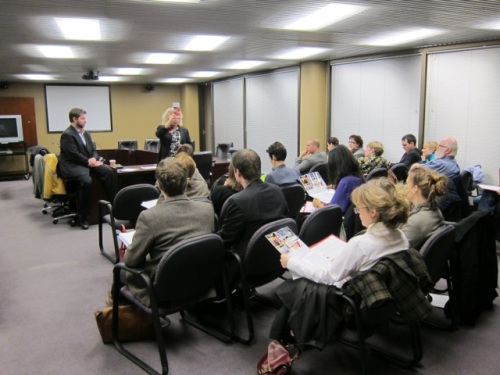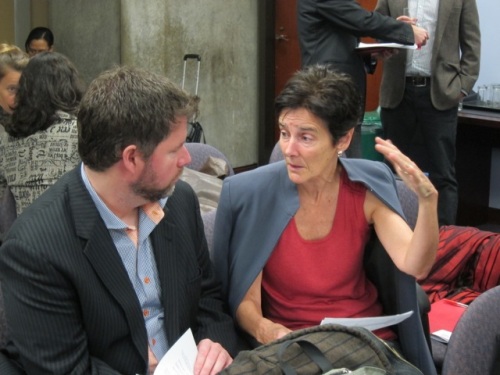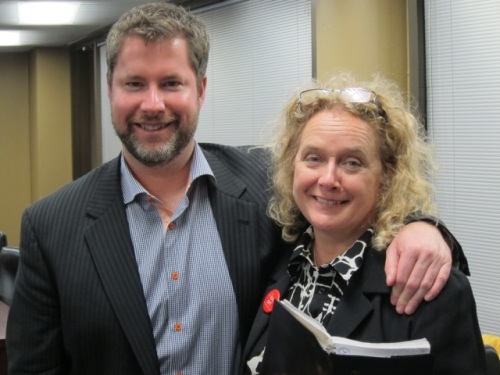Participants presented a strategic message about the economic and social impact of culture on our city, and reminded Councillors of the commitment they made to increase investment by 30% over time through the adoption of the Creative Capital Gains report in May. There were three consensus priorities conveyed: invest competitively in the sector, lead the way in championing our rich cultural assets, and make affordable cultural spaces available across the City.
To the credit of participants, Councillors of all persuasions expressed support for a strengthened cultural agenda at City Hall. For the most part they even agreed that cuts to the sector are not warranted. Though despite their affirmations, some were shy to fully commit their vote until the budget is presented and negotiations begin. It seems apparent that the highly politicized environment at City Hall is leaving Councillors feeling restless and unsure about the fate of many city services and culture is no exception.
Given the circumstances, Arts Day was a very timely effort by TAPA and Friends of the Arts who worked hard to rally voices around a unified message and secure meetings with key Councillors. On the heels of a contentious core city service review, City Council is on the precipice of the sure-to-be equally controversial budgeting process. On November 28th, City Manager Joe Pennachetti will present the budget, reflecting the overall 10% cut to spending mandated by Mayor Ford. It is expected that not all divisions will be treated the same, though many programs and services will loose the baseline 10%. Others will absorb either more or less. Sound familiar? Like Stephen Harper’s Deficit Reduction Action Plan, Ford’s budget goals force all departments to face cuts.
We are operating in an environment where the question is no longer IF there will be spending cuts, but how much and to what. It’s possible that the City will not see culture as a target, and tread softly on this already fragile portfolio. One could imagine that there may indeed be some efficiency savings to be found, though one could also imagine reinvesting these savings into the sector… a step that Ford won’t support if he is to achieve his bottom line.
But unlike Harper, Ford isn’t guaranteed the favour of his government and he must convince a majority of Councillors to support his agenda. And so begins the highly politicized bargaining process that will dominate discussions in Council Chambers come November 28th. Motion after motion will cause the budget to shift and change as each proposition is debated and voted on. The budget process also allows for public consultation. Budget deputations are slated for December 8th and this day is sure to be another overnight circus similar to the consultations surrounding the service review.
Despite whatever news we may receive November 28th from Pennachetti, until the process plays itself out fully, the outcome will remain anyone’s guess. An important window exists starting now until the budget is passed early in the New Year to engage in the debate. Councillors want to hear from their constituents and in the coming weeks it will be critical that the arts sector organize its efforts so culture priorities are heard across all wards from local constituents.
Here are some things you can do:
1 – Show Councillors that Torontonians love the arts and sign the Friends of the Arts petition. This petition has nearly 20,000 signatures and will be presented to City Council on November 29th. Already signed it? Send it to 10 of your favourite arts supporters and ask them to sign too! Posting on your Facebook page works too.
2 – Might as well join the circus and sign up to make a budget deputation on December 8th. Or, if your routine is a little rusty, simply make an appearance at City Hall that day to show your support for the other arts and culture acts. Mike Layton offers a user-friendly blog post that explains the process.
3 – Re-live Grade 7 all over again and make a trip to City Hall to visit your Councillor! Bring an arts supportive friend from your ward who doesn’t work in the arts. If Grade 7 was a bad year for you and you’d rather stay home, a phone call is the next best thing. Or an email. An email is ok too. Find your Councillor here.
Don’t forget to review key messages and priorities endorsed by Friends of the Arts (including the Toronto Arts Foundation, ArtsVote Toronto, Arts Etobicoke, TAPA, Creative Trust, Lakeshore Arts, Scarborough Arts, BeautifulCity.ca, Business for the Arts and Urban Arts).
KEY MESSAGES
FACTS and FIGURES
Once the city’s draft budget is announced November 28th, Friends of the Arts will prepare and distribute a new message reflecting new information. Stay tuned…!
Meanwhile enjoy these snaps from Arts Day at the City.





















